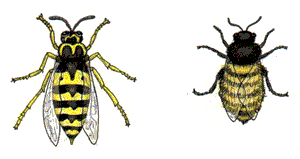Honey bees are definitely on the side of the good guys in our home landscapes. Bees make our honey and are essential for the pollination of many flowers and trees in our yards. In fact, Honey bees are our most numerous and loved pollinators. These hard working critters are relatively small hairy insects. They vary in color from the usual golden brown to darker browns and even black. Do not mistake the honey bee from the more cantankerous yellowjacket.
 |
| Yellowjacket on left Honeybee on the right |
Honey bees cause concern under several circumstances
1. If your lawn has a large percentage of clover in it, the clover blossoms, when they appear, will be very attractive to honey bees out searching for nectar. This is not usually a problem until a youngster or an adult walks around in the lawn in their bare feet. If the clover is not in blossom, this is not going to be a problem.
2. The box-like hives used by hobby and commercial beekeepers can become too crowed for a given colony of bees, and a group of bees (a swarm) will leave to start a new colony. Frequently such swarms settle temporarily on the side of a house or on a tree branch. These swarms usually move on to a more permanent spot away from your yard in a few hours.
3. On the other hand, a group or swarm of wandering bees can start a new hive in a hollow tree or worse within the walls of your house. These permanent homesites cause the greatest problem. Honey bees tend to defend their new home against any inexperienced intruder. Honeybee nests are perennial. These insects survive the winter by huddling together forming a tight warm cluster.
Honey bees can be very defensive toward anyone approaching their hive. Alarmed workers release substances from glands in the sting apparatus and mouth parts which cause other bees to attack, and thus, mass stinging incidents can occur. Unlike most other stinging insects, a honey bee can only sting once since it loses the stinger imbedded in the victim and subsequently dies, the ultimate sacrifice for the good of the community.
Controlling Honey Bees Without Insecticides
If the bees are living in a hollow tree you should do nothing except find a professional beekeeper or an exterminator to deal with the problem.
When bees nest within the house structure the problem becomes involved and costly. One may wait until the temperatures drop to near freezing or below and slowly expose the nest allowing the cold weather to kill the unprotected bees. Beekeepers can sometimes come in to attempt to trap the hive which removes the adult bees with the exception of the queen and a small number of workers. This technique, should not be attempted without experiences supervision. Trapping a hive takes approximately two months and it is not always successful. In most cases a professional exterminator is necessary for the removal of a colony.
Once the bees have been trapped or killed the nest itself should be removed. The honey and beeswax will attract other insect and animal pests, while the odor of fermenting honey can be quite strong. During warmer weather the combs often weaken and dripping honey may cause unsightly damage. Once the comb and honey have been scraped away, the area should be washed; insulation or a similar material packed into the former nest area and all potential entrances should be sealed.

